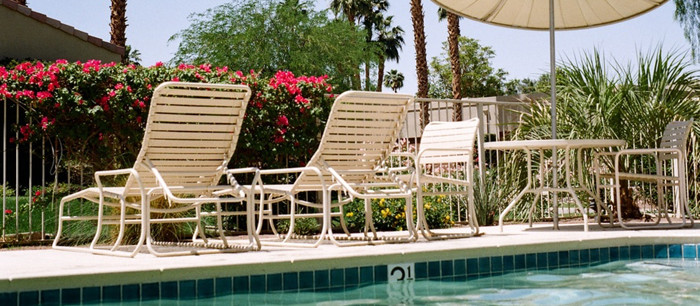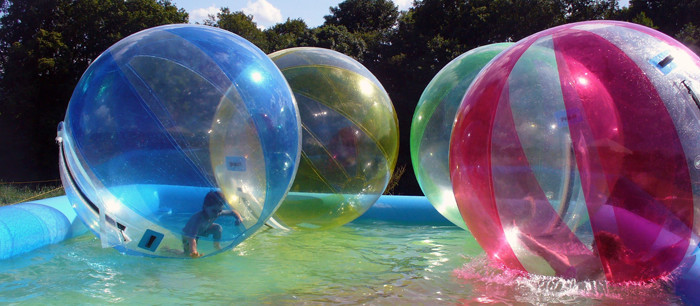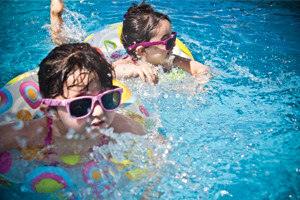As early summer chores go, uncovering swimming pools and spas after the long and cold winter is one of the best. These warm-weather focal points of family fun keep kids and grownups entertained for months and make cooling off (and relaxing) easy. But they also pose a threat to kids whose enthusiasm for water play and immaturity make them vulnerable.
According to the Consumer Product Safety Commission, 300 children under five years old drown each year in backyard swimming pools. That statistic can be difficult to hear for families who love to swim, but the good news is that drowning incidents are largely preventable.
Here are 5 ways you can childproof your pool or spa so summertime fun stays relatively worry free.
1. Create safe areas around the pool

The number one way to ensure pool safety is to simply block access. The more safeguards you have in place, the better, because your job is not only protecting your own children from danger, but also making sure your pool or spa doesn’t pose a risk to neighborhood kids.
- Covers: The highest quality pool covers will support the weight of an average adult without breaking or warping and many spa covers are so heavy that children can’t lift them. Consider covers – which should be locked in place whenever the pool is not in use – your first line of defense against accidents. Make sure to drain rainwater that collects on top of the cover or choose a cover that allows water to drain into the pool.
- Fences: Your community may actually require that your pool or spa be surrounded by a fence with a lockable gate by law. If not, consider installing a pool fence anyway to ensure that your pool is off limits between supervised swims. Choose a self-closing, self-latching gate, and keep anything that children could use to scale the fence well away from the pool.
2. Install alarms and keep them armed
You can take precautions to block access to your pool, but even young children can figure out how to get past covers and fences if they’re determined. The next best way to ensure your pool or spa stays safe is to know when someone has jumped (or fallen) in. An alarm on your pool fence will tell you when someone is near the pool, and there are also two types of alarms that you can install on the pool itself.
- Wave alarms: This type of alarm sounds when a person or object falls into the water by sensing waves in the pool. However, these alarms are often so sensitive that they give lots of false alarms or only responsive when the person or object falls in relatively close to the alarm or is heavy enough to create noticeable waves.
- Light alarms: These alarms shoot a light beam around the water’s perimeter and if that beam is broken, the alarm sounds. Light alarms do double duty because they let you know when a child is near the edge of the pool.
3. Keep pool equipment from becoming a hazard
Make sure that your pool heater, filter, chemicals, and other equipment are stored behind sturdy fencing – preferably a fenced in area with a locking gate. Never use the pool or spa when an automatic cleaner vacuum is operating because the hoses can entangle even competent swimmers. Store the steps to above-ground pools in the shed when not in use. And keep in mind that the strong circulating action of spa pumps and drains can pull a smaller child off their feet so the safest option is to turn off the pump when you’re having a family soak.
4. Maintain the yard around the pool

Pool deck damage should be treated as a priority repair because slippery or cracked concrete or wood can lead to trips and falls. Keep all toys – especially balls – away from the perimeter of the pool, and always use plastic cups and plates if you’re dining al fresco. Make sure that all outlets and electrical equipment is protected with ground fault circuit interrupters and test GFCIs monthly. Never install electrical equipment inside a fenced pool area.
5. Make pool safety a whole family habit

Whether or not kids can swim, there should always be at least one adult capable of rescuing someone in distress present during pool time. Never leave children unattended – not even for a minute! Insist that non-swimmers wear floatation devices like Puddle Jumpers, which make it almost impossible for kids to end up face down in the water. Sit down as a family and create a list of pool rules that you all agree to. Learn CPR! And finally, if a child goes missing always check the pool first and always keep a phone near the pool while swimming in case of emergencies.
Want more information about keeping kids safe? This blog is part of a series on how to childproof different areas of your home, inside and out. Previously we’ve covered childproofing your living room, childproofing your kitchen, childproofing the bedroom, and childproofing the bathroom.


